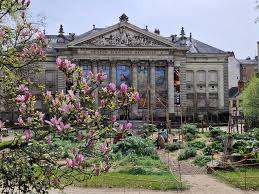Musée d'Histoire de Nantes
Expansive museum tracing the city's history, including exhibits on the French slave trade, located in the Château des Ducs de Bretagne.Entrance fee: https://www.chateaunantes.fr/en/practical-information/admission/
Opening hours and closing days: https://www.chateaunantes.fr/en/practical-information/admission/

Access preferences
- Animals (Animals)
With the exception of guide or service dogs, dogs are not allowed inside the castle.
- Cognitive accessibility (General)
We have specially designed documents, a sensory map, and a photo booklet for autistic people to make their visit enjoyable.
Before your visit, you can use them to prepare for your tour.
During your visit, they’ll help you structure your itinerary.We can also lend you sound-blocking headphones. You can also bring your own tools (sunglasses, timer, etc.).
- Easy reading (Easy Read & Understanding)
A booklet has been designed to help visitors get to know the Château and its museum.
Informational cards called “Les œuvres à la loupe” (i.e., “art works up close”) in Easy Read (French) make it easier to discover a selection of museum objects.
The variety of complementary media (simplified maps of Nantes, films, interactive elements, Easy Read cards) and informational tools (touch, image, sound) allow everyone to enjoy the site and its rich content. In temporary exhibitions, Easy Read info cards (in French) and interactive play areas are at your disposal.
- Entrance (Accessible entrance for pushchairs and wheelchairs)
Accessible entrances
Parking space for strollers- French Sign Language (Sign language)
A tour of the Château and Musée d’histoire de Nantes in FSL is available via visioguide (i.e., “video-guide”) allowing you to discover the castle on your own, alone, or with others. The tour includes around 30 filmed commentaries interpreted by deaf actors.
FSL translations are visible on video screens in rooms 2 and 6.
Guided tours in FSL are regularly scheduled.- Hearing accessibility (Acoustic Experiences)
Both ticket offices, as well as the bookshop, are equipped with a hearing induction loops.
The videos in rooms 4, 8, 13, and 20 are subtitled in French.
To listen to films about Anne de Bretagne, the history of the castle, and post-war newsreels, you can use an audioguide equipped with an induction loop necklace.- Mobility (Getting around inside the museum)
Most of the Château des Ducs de Bretagne is accessible to guests with reduced mobility.The courtyard surface is flat and stabilized. The moat garden is also accessible
However, each building is surrounded by a cobblestoned square. Part of the ramparts is accessible via elevator.28 of the museum’s 32 rooms are accessible, as are the exhibitions in the temporary exhibitions building.
Signs and the specially designed map make it easy to get around. You can visit the museum and exhibitions in complete autonomy.- Motricity (General)
Seating and rest areas are available in the Château courtyard, in the Museum (rooms 6, 17, 22 and 30) and in the temporary exhibitions. Wheelchairs and strollers can be borrowed from the museum and temporary exhibition reception desks.
Portable seats are available at reception, in room 5, and on the footbridge between rooms 17 and 18 of the museum, as well as in the temporary exhibitions building.
- Reading (Easy Read & Understanding)
Magnifying glasses are available at reception.
You can also request an audioguide with commentary.- Tour autonomy (Tactile Experiences)
A tactile, audio-guide tour of the Château and Musée d’histoire de Nantes
This itinerary has an audioguide made especially for it, as well as tactile and sound devices throughout the different rooms. Audioguides can be borrowed from the reception desk. They are free of charge.63 listening stations are available, each describing the room and themes explored, along with tactile texts with suggestions for what objects to touch, maps in relief, and large print, as well as audio descriptions.
New: tactile tables allowing guests to discover the collections in rooms 4, 7, 10, 11, 13, 19, and 25 have been developed with the support of the Pays de la Loire Regional Cultural Affairs Department (DRAC) and the French National Accessibility Fund.
Contact info
Musée d'Histoire de Nantes,
4 Pl. Marc Elder,
44000 Nantes, France.
+33 811 46 46 44
contact@chateaunantes.fr
https://www.chateaunantes.fr/en/evenements/visiting-solo-nantes-history-museum/